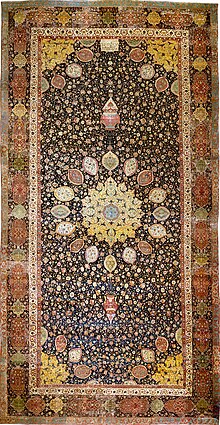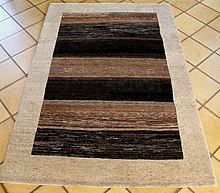
Back سجاد Arabic Alfombra AST Xalça Azerbaijani خالچا AZB Дыван Byelorussian Ketipah BEW Мокет Bulgarian Ambal BJN Tepih BS Catifa Catalan
This article needs additional citations for verification. (March 2017) |


A carpet is a textile floor covering typically consisting of an upper layer of pile attached to a backing. The pile was traditionally made from wool, but since the 20th century synthetic fibers such as polypropylene, nylon, or polyester have often been used, as these fibers are less expensive than wool. The pile usually consists of twisted tufts that are typically heat-treated to maintain their structure. The term carpet is often used in a similar context to the term rug, but rugs are typically considered to be smaller than a room and not attached to the floor.[1]

Carpets are used for a variety of purposes. These include insulating a person's feet from a cold tile or concrete floor, making a room more comfortable as a place to sit on the floor (e.g., when playing with children or as a prayer rug), reducing sound from walking (particularly in apartment buildings), and adding decoration or color to a room. Carpets can be made in any color by using differently dyed fibers. Carpets can have many different types of patterns and motifs used to decorate the surface. Carpets are used in industrial and commercial establishments such as retail stores and hotels and in private homes. Today, a huge range of carpets and rugs are available at many price and quality levels, ranging from inexpensive, synthetic carpets that are mass-produced in factories and used in commercial buildings to costly hand-knotted wool rugs that are used in private residences.
Carpets can be produced on a loom quite similarly to woven fabric, made using needle felts, knotted by hand (in oriental rugs), made with their pile injected into a backing material (called tufting), flatwoven, made by hooking wool or cotton through the meshes of a sturdy fabric, or embroidered. Carpet is commonly made in widths of 12 and 15 feet (3.7 and 4.6 m) in the US and 4 and 5 m (13 and 16 ft) in Europe. Since the 19th and 20th century, where necessary for wall-to-wall carpet, different widths of carpet can be seamed together with a seaming iron and seam tape (formerly it was sewn together) and fixed to a floor over a cushioned underlay (pad) using nails, tack strips (known in the UK as gripper rods), adhesives, or occasionally decorative metal stair rods. Wall-to-wall carpet is distinguished from rugs or mats, which are loose-laid floor coverings, as wall-to-wall carpet is fixed to the floor and covers a much larger area.
- ^ "Definition of CARPET". merriam-webster.com. Retrieved 23 June 2022.